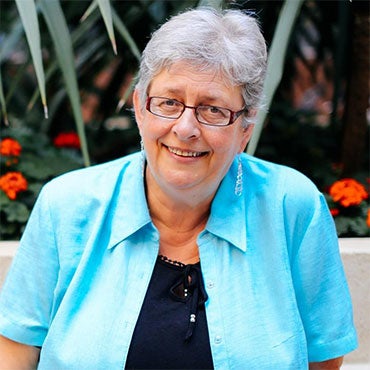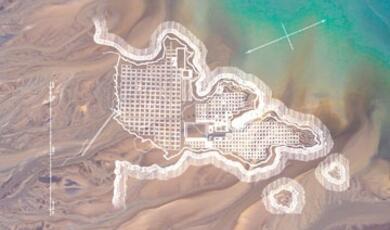Something in the Air: The Insidious Challenge of Air Pollution
Share
- Details
- Transcript
- Audio
- Downloads
- Extra Reading
Smoke from burning forests, and photochemical smog in Beijing and Delhi are visible from space, but most of the air pollution in cities such as London is invisible even at ground level. The WHO suggests that the cost of contamination within Europe alone amounts to $1.6 trillion, with massive implications for the health of both rich and poor people alike. How much do we know about this, and can anything realistically be done about it?
Download Transcript
12 January 2017
Something in the Air:
The Insidious Challenge of Air Pollution
Professor Carolyn Roberts
Good evening everyone, and welcome both to Gresham College and to online watchers and listeners. Tonight, I am going to talk about air pollution, one of the most insidious challenges that bedevils all of us, environmental scientists included, this century. I am not going to be talking tonight about greenhouse gases and climate change (at least not directly) but about some of the other chemicals that human activity releases into the atmosphere, and which we may then breathe, or which adversely affect ecosystems and the built environment.
The story of air pollution management in the UK and elsewhere could be told as one of great success. Seventy years ago there were some major problems in our cities. Those old enough to recall the choking London ‘pea souper’ fogs of the 1950s and earlier will know that since the UK Clean Air Act was passed in 1956, and sulphurous coal and wood fires were banned in city areas, visible black smoke has almost disappeared. In fact, there was a lot of opposition to the ban at the time, since domestic coal fires were seen then as a powerful symbol of post-War British prosperity, whereas today it is probably the size of the TV screen that designates relative wealth and comfort. Each has their environmental impact, of course. The slide shows the additional 3- 600 deaths per day in London that occurred over several days in December 1952 when wind-speeds were low, temperatures cold, and open fires were common in the capital. The coal-fired Bankside A Power Station, now the site of Tate Modern, was then depositing an estimated 235 tons per square mile of so called ‘grit’ in the area during the month of September 1950 (as measured by London County Council) which is probably not a coincidence. Coal-fired power stations have also almost disappeared in our cities.
Internationally, there have been some successes as well. Through the 1987 Montreal Protocol for example, we have addressed the long-lived, atmospheric chlorofluoocarbon (CFC) emissions from refrigerants, dry cleaning fluids, aerosols and packaging materials that eroded a hole in the Antarctic ozone layer. CFCs are manufactured organic compounds containing carbon, fluorine and chlorine (often known as the ‘Devil’s Element’), commonly known by the DuPont brand name ‘Freon’. The fact that stratospheric ozone protects humanity and other life from harmful incoming ultraviolet radiation had been known for decades, but its sudden depletion as a result of chemical interaction with CFCs (involving NOx gases too) was discovered only in 1985 by three scientists from the British Antarctic Survey, in Cambridge - Farman, Gardiner and Shanklin. As with many natural environmental components, the Antarctic ‘ozone hole’ swirls and pulsates, growing and shrinking annually and responding to natural ozone variability as we see in the video clip here; that can make evaluation of longer term trends challenging. In fact initially, the satellite observations of low Antarctic ozone levels were through to be erroneous, and the extent of the damage only became apparent after instruments were recalibrated using ground-based observations. A similar but less marked depletion of ozone has occurred in the cold polar clouds of the Northern hemisphere too, as CFC use has dropped.
The scientists were initially vilified by the sellers of CFCs, but international agreement on a ban nevertheless took place very quickly indeed. Some time was required to develop replacement refrigerants and coolants, and there is still some CFC smuggling into developing countries, but banning their use has been a good start and I do not think they are much missed now. The problem is actually not yet entirely ‘solved’ as the hole is not expected to heal fully until 2060, and in fact it was at its greatest extent in 2015 because of a volcanic eruption in Chile. But the power of international negotiation towards a common goal was demonstrated despite the short term economic cost – a positive message. Professor Susan Solomon, who alongside a group from Leeds University leads an MIT team, notes that the precise lesson on collaboration is less than clear. On the pessimistic side, it might be said that a modest-sized global environmental problem can be solved by the world, while a mega-sized one is another matter entirely. This was a chemical industry whose value was measured in the billions, not the trillions of pounds that is tied up in climate change-related companies in the energy sector. But there is still some cause for optimism.
To take another example, in the 1980s and 90s environmental researchers and even politicians in developed countries talked a great deal about ‘acid rainfall’: sulphur dioxide and nitrous oxides that had entered the atmosphere from industrial smokestacks and power stations and been washed from the atmosphere downwind by rain and snow, or had fallen as a gentle shower of caustic dust. Even today, occasional rain and fog pH readings of below 2.4 are reported in industrialized areas; that is about the same level of acidity as undiluted Coca Cola (Pepsi seems to be slightly less acidic!), and you will know what that does to human teeth. The acidity created such excesses of hydrogen ions in soils and lakes that it killed trees either directly, or by allowing metals such as lead and mercury to be released into solution. Scandinavian forest and moorland ecosystems were particularly vulnerable and suffered from the UK’s acid rain emissions, but European protocols were developed from the 1980s requiring ‘scrubbing’ technology to be installed in smokestacks. This had demonstrable transboundary benefits to ecosystems and fish over the succeeding years. The reductions in the use of coal, in 2016 providing less electricity in the UK than wind power for the first time (and none at all in May 2016), is a more recent contributory factor as well. The USA has had a similar experience, following legislation enforced by the US Environmental Protection Agency.
Sulphur dioxide emissions also increased the erosion rate of materials in our historic buildings and monuments. At St Paul’s Cathedral, for instance, investigations showed that exposed Portland limestone had often decayed to a powder under a thin and dirty skin of harder stone. Surface erosion rates between 1710 and 1980, the really dirty period for London smogs, were roughly double what they are now. Sulphur dioxide levels have fallen dramatically over the 30 year period since the monitoring began, and today are at low levels of about 3 parts per billion, a fall of about 95% since the early 1980s. This fall mirrors the situation across Europe, and no European cities are now above the sulphur dioxide limit values set by the EU. So, that’s another international success story for managing atmospheric pollution.
However, despite these triumphs, and I could also have talked about removing lead from vehicle fuel, some serious problems persist. On October 2016, the morning after last year’s Diwali celebrations, the Indian city of Delhi was encompassed in a huge bubble of smog made up largely of tiny particles and droplets of carbon (classified as PM2.5, or less than 2.5 microns in diameter) in concentrations sufficiently high to cause eye and throat irritation, and to penetrate human lungs and enter people’s bloodstreams. On a day when winds were slowing after the monsoon, firework residue was added to the normal atmospheric load of car exhaust, road dust and smoke from open fires, causing the monitor at the US Embassy to record a PM2.5 figure of 9999 μg/m3; the ‘safe’ legal limit for India is 60. Before we dismiss this as something bad but far away, note that an air quality monitor in Farringdon, only 500 metres from where we are tonight in Holborn, recorded a PM2.5 figure of 139 μg/m3 on the same day. I will return to London in a few minutes.
Some of these smoke-related air pollution episodes are so large and intense that they are visible from space. Research by NASA in the second half of 1997 showed particles from burning Indonesian trees and peat remaining stagnant over Southeast Asia, while tropospheric, low-level ozone contamination spread more quickly westwards across the Indian Ocean towards India. Ozone is toxic to humans, despite its benefits high up in the stratosphere. These intricate atmospheric circulation patterns are likely to change in the face of climate shifts too, particularly changes to the intensity and timing of El Niño, which alters the date at which wet season starts and fires are damped down. It makes for complexity in the science.
Like low level ozone, other contaminants are also invisible to the naked eye but detectable by specialist monitors carried on satellites, as this very recent NASA video on nitrogen dioxide indicates. I am wondering whether NASA might rather regret broadcasting the last few moments showing the link between recent increases in nitrogen oxides and increased fossil fuel extraction, given incoming President Trump’s personal and family interests in promoting oil, gas and fracking; NASA is very reliant on public funding.
There are very recent acute incidents too. A ‘red alert’ in late December 2016 prompted the closure of factories in many northern Chinese cities, the grounding of flights and limits on the number of cars to reduce pollution. Authorities in Beijing temporarily suspended operations in 700 companies, and hospitals experienced a major spike in admissions for air pollution-related illnesses and breathing difficulties, especially amongst children. The pictures here tell the story, as reported by the Daily Mail, Reuters and many others. This is a typical situation for many megacities in the developing world, whether or not the atmospheric pollution is actually visible, although often it is (nitrogen dioxide is actually yellowish). And in the case of China, it is almost certainly a partial function of the inextricable economic links between nations. The West has effectively exported some of the worst excesses of its air pollution to manufacturing intensive nations such as China, India and Thailand. We in the West are partly responsible for the damage created elsewhere.
Globally we see largely explicable patterns of air pollution. The maps show some of the worst affected cities and regions for various air pollution parameters, based on World Health Organisation analysis. PM10 particulates are fine dust or smoke particles, which float in the air and reduce visibility. Some particles are naturally generated as desert dust, from natural fires and volcanoes, and as sea salt crystals. The 2016 figures show that more than 80% of people living in the 3000 reporting urban areas are exposed to pollutant levels exceeding the World Health Organization-defined ‘safe’ limits. While all regions of the world are affected, populations in low-income cities are the most impacted, 98% of those in cities in low and middle income countries, as opposed to 56% in high income countries. A vast swathe of the globe from China through the Far East, India and the Middle East, has excessive PM10 levels, with hotspot outliers in Nigeria, and Central America. Onitsha in Nigeria has the dubious honour of being the most polluted city. These maps and listings, of course, show only those 103 countries that do routinely monitor and publish air pollution data, which Nigeria does. Russia, by-and-large, does not.
PM2.5 particles are finer and lighter, more susceptible to being inhaled, and create lung problems including cancers. Again a product of incomplete combustion in engines, power plants and industrial premises, and open cooking fires, the poorer areas of the world have the greatest problems with these very fine particles.
London is the only UK city where the daily limit value for PM2.5 set by the World Health Organisation is regularly exceeded, largely a function of exhaust fumes from diesel traffic, at least as far as understood from monitoring and modelling. However, for nitrogen dioxide, a yellowish gas emitted particularly by vehicles, the United Kingdom fares much worse than other European areas, and pollution limits set by the EU (40 µg/m3) for 2012 are periodically exceeded in eleven cities in England and Scotland. These cities include Aberdeen, Glasgow, Liverpool, Bristol, Manchester, Birmingham, Oxford and London, where daily averages of over 45µg/m3 were recorded. Moreover, there is only limited sign of significant reduction in the average over the last ten years. We may have solved the sulphur dioxide problem, and stopped our ancient monuments being continually washed with sulphuric acid, but London remains one of the most polluted of the UK cities for nitrogen oxides. King’s College London researchers who run the London Air Quality Monitoring Network found that Brixton Road breached the EU annual air pollution limit by January 5th, Twelfth Night. EU law states that the average hourly level of NO2 must not exceed 200 µg/m3 more than 18 times a year; Brixton road exceeded this annual limit 19 times in the first five days of 2017. At one point, NO2 levels were nearly double the legal limit. Similar pollution problems are found along many of London’s main roads, including Oxford Street, Kings Road and the Strand. Allegedly, Oxford Street has the worst nitrogen dioxide pollution in the world. A team from UCL and Kings also publish some very interesting 3D visualisations of nitrogen dioxide levels at the scale of individual streets, based on monitoring at points and modelling what happens in between the monitoring stations. You can see one of these in this short video clip. Urban air pollution remains a challenge almost everywhere in the world.
The global economic cost of air pollution is absolutely staggering. The definitive study on this was undertaken by the World Health Organisation in 2012 suggested the total cost at trillions, a figure supported by the World Bank in 2013 who suggested $5.4 trillion in lost work days and social costs. In 2016 the World Bank suggested that the annual direct cost to the global economy was $225 Billion, and that it impeded development in places such as India and Cambodia, both of which were losing about 8% GDP through it. China lost 10%. Dirty UK air may have cost us £5.6 Billion per year, even though we have exported some of it, either literally or figuratively. I will just pause for a minute there.$5.4 trillion. This might be thought to be an act of collective insanity.
However, even those figures may be underestimates, because of the services that the environment provides that are dependent upon a good quality atmosphere. Farming and horticulture are good examples. The deposition of dust may reduce the growth rates of crops, and affect their value when sold; people do not want to buy and eat dusty or dirty vegetables. Bees have recently been discovered to be influenced by air pollution for example, according to scientists at Penn State University, because they can apparently no longer detect plumes of flower scents, or the scents themselves may have been altered by chemical reactions with ozone and other pollutants. This is potentially of massive significance for the pollination of major food crops, as the bees in polluted areas spend much longer foraging, and find less food to bring back to the hive. For crops where insect pollination is important, this is a vital ecosystem service diminished, and with a lot of value.
Air pollution reduces the ‘natural capital’ of the earth, and diminishes the value of these ‘ecosystem services’ or functions of the atmosphere. It is possible, though it may not always be wise, to put an actual monetary value on such services, or rather the value of the ecosystem services lost, because it becomes difficult to balance trade-offs. Would we rather have fresh air, or a forest, for example, if we can trade one cost for another? The UK’s pioneering National Ecosystem Assessment was published in 2011, and is arguably one of the most comprehensive overviews of the state of the natural environment in any country, and of ecosystem services. At European level, the EEA executive director Jacqueline McGrade suggested that pollution costs, one trillion euros a year in health care and dealing with the wider impacts on ecosystems across Europe. I recent press reporting she added that, on average, pollution is still reducing life expectancy by around eight months across European cities. In some areas it is as much as 22 months.
The adverse health implications of even relatively low levels of very fine atmospheric particulates (particularly PM2.5) have been identified by researchers in the USA since the 1990s, research that despite the efforts of some industrial stakeholders was picked up in Europe and used to inform policy development. We know what the health implications are, and we can see what air pollution does to lungs. It is estimated that some 29, 000 early deaths per year across the UK, are the result of air pollution, of which about 4,000 are in London. A 2010 study suggested that the death rate in London associated with PM2.5 was 7.2 per thousand people, equivalent to 3,389 people. This is a larger number than typically die on our roads. The variations in weather have subsequently allowed people to argue about the exact figure, and whether it is locally rising or falling in Westminster or Bromley (in fact it appears almost stable) but there is no doubt that it is appalling and that bold measures appear to be called for. Elsewhere in the UK, the situation is similar; London, Birmingham and Leeds for example were the subject of a recent ruling by the Supreme Court because they are unlikely to meet nitrogen dioxide EU limits until after 2030.
To my mind, improving air quality depends first and foremost on understanding the science, and thereafter on having the economic power and the political will to address the challenges.
The science of air quality is tough enough to handle, as we have seen. Different chemicals may themselves react with one another, to generate what is often called ‘photochemical smog’. The range of contaminants is huge, well beyond those on which I have focussed tonight. Research at Lancaster University for example is looking into persistent organic pollutants to assess the effectiveness of source abatement measures and the factors controlling ambient levels. Target chemicals have been polychlorinated biphenyls (PCBs), polycyclic aromatic hydrocarbons (PAHs), polychlorinated dibenzo-p-dioxins (PCDDs), polychlorinated dibenzofurans (PCDFs), and, since 2010, polybrominated diphenyl ethers (PBDEs). Since 1991 their monitoring network has collected air samples at six sites across England and Scotland, providing long term air trend data at both urban and rural locations, and enabling Government to evaluate the effectiveness of international regulations and protocols.
But ambient air quality is influenced not only by the actual emissions of contaminants, from point sources or more dispersed ones. The weather, temperature, winds speeds and turbulence, the design of urban areas with canyons or open spaces, and the actual monitoring technology are all fraught with difficulties. Moreover, exactly how you do the sampling, what you sample, when and where, and for how long, are crucial questions. Modelling air quality, using points of data to understand variability over space and time, and to represent it in a way that enables a response to be made in real time or in the longer term, is well on the way but is perhaps mainly a palliative exercise because action remains necessary to reduce the levels of emissions, not just to facilitate increased dispersion and the consequent transboundary contamination. These are the first steps to crack what is now an insidious problem.
There have been localised rather astonishing technological ‘solutions’ to air quality problems but that are not sustainable. At the most basic level, you can wear a mask, or if you have more money, a filter as this child in China is wearing. Elsewhere in China, a ‘Smog Free Tower’ is touring around, that pulls in airborne particulates electrostatically. The smog particles that are collected are apparently being compressed into small cubes and used to create jewellery. Each cube is said to contain 1,000 m3 of particles and is set into a ring that can be worn as a souvenir of clean air. If you believe that, you will believe anything! In Beijing, 300 have apparently been made, but I have no records of sales. The tower relies on an electrical power supply, powered in the main by, you have guessed it, coal fired power stations. Another solution, a roof mounted vacuum cleaner has been trialled in Amsterdam. These devices rely on someone paying for them, and for their running costs. How effective they are is not yet reported, but they are rich people’s playthings.
Rather less problematically, and certainly cheaper, if you turn on your mobile phone today and search using various apps, you will find an offering of interactive and real time information showing air quality problems in London streets, enabling you to avoid the hotspots. Cyclists and pedestrians in particular can modify their journeys to minimise the risk of a sore throat, an asthma attack or worse. Kings College London researchers are again pioneers here, with a phone app that provides exposure information based on hourly readings at monitoring stations across the conurbation. In due course these observations may start to influence house prices. Drayson Technologies is also selling a £75 ‘tag’ that you wear around your neck, and which measures carbon monoxide, syncing with your phone on an app called ‘CleanSpace’ and giving you advice on your exposure. It also gives you ‘rewards’, and generates a massive dataset to add to the 120 stations already monitoring in London. The direct intention is to influence people to avoid the pollution, but perhaps the longer term implication is that by raising public awareness, they may start to bring pressure on legislators.
If you are sufficiently wealthy, of course you can buy a house in an area that has generally better air quality, and there is plenty of research evidence amongst rich Chinese urbanites that they are doing that to avoid the problem. They also spend a lot of money on room air filters during peak PM2.5 particulate pollution events notified to the public by the Chinese Ministry of Environmental Protection, whereas poorer people tend to buy ineffective paper masks; air pollution is a polarising phenomenon for life inequality at local and national levels. Air pollution monitoring is undertaken in China, and measures are taken in acute events to reduce traffic and stop industrial emissions. The chronic levels are still not fully addressed in many areas of the world, however.
Machines that filter the atmosphere, the adoption of personal protection measures and the avoidance of the most highly toxic environments are not sustainable solutions for this, of course and it seems most likely that reductions of emissions at source, backed by monitoring and modelling that informs and prioritises local action mandated by legislation are required.
The first known air quality management legislation was passed in 1273, dealing with smoke abatement, and in 1306 coal burning was banned in London, a restriction subsequently forgotten and reiterated several times in subsequent centuries as smogs continued periodically in London and elsewhere. The Clean Air Acts of 1956 and 1968 allowed, allowed mind, Local Authorities to establish Smoke Control Areas in towns, where only ‘clean’ fossil fuels could be burnt. Not all authorities did. They also gained some potential power to prosecute dirty industries, such as scrapyards burning off plastic cable coverings, and some used it. Other authorities were concerned about the costs for local industries, and did not, or phased in their domestic control areas more slowly, starting with upwind locations regardless of the downwind impacts outside their regions. We can start to see the implications of the legislation coming in on UK levels of air pollution, but it is also apparent that social attitudes are also significant drivers of change; coal became rather less important as a domestic fuel, for instance, reducing sulphur dioxide. There are no sharp drops associated with particular periods of legislative activity, rather a more generalised fall in monitored levels, albeit not enough to avoid the health problems as we now understand them.
Since the 1980s UK air quality legislation has been driven principally by EU strategies and Frameworks, obliging the UK to monitor, report and achieve specific ambient air quality levels, over different time periods such as a day, or an hour, or instantaneously (should the monitoring exist). We have seen already how this worked in reducing sulphur dioxide emissions and acid rainfall across Europe. UK industrial emitters of air pollution were covered by the Environmental Protection Act of 1990, whilst the Clean Air Act of 1993 addressed smoke, and the Environment Act of 1995 incorporated specific ambient air quality standards. By 1997, a UK Air Quality Strategy had been produced by Government, covering a whole range of emissions from sulphur dioxide, lead, nitrogen dioxide, and later on carbon monoxide, benzene and ozone, to very recently arsenic, nickel, cadmium, mercury and polynuclear aromatic hydrocarbons. Some of the EU strategies set limit values, and some set target values (for instance a 2010 nitrogen dioxide target, and interim values for other parameters for 2020), but all are based on current scientific understanding of the health impacts. However, EU strategies are only advisory, not legally binding and in relation to the PM2.5 figures at least, there is a continuing debate about complexity in the arrangements, and whether the limit or target figures are too high, and therefore too easily achieved. Despite this, of course, the UK is frequently in breach of the standards, as we have seen. Confusion between the EU and the UK perhaps provides ready ammunition for the sceptical.
I will not review the EU regulations affecting vehicle emissions, but most of us will be familiar with the requirements on catalytic converters, which can reduce emissions of most of the relevant compounds by 90% in comparison with uncontrolled vehicles. Exactly how the tests are done for these is, of course, a matter of a recent scandal in the case of Volkswagen and other manufacturers; a charitable view would be that they have been shown to have been tampering with the results, and on 11th of January (yesterday) they were found guilty of a criminal charge In the US and fined some billions of dollars. In reality, the vehicle test cycles do not adequately mimic realistic driving, and although target figures for vehicles have been lowered, actual emissions have not decreased. It is possible that the catalysts and filters do not reach sufficiently high temperatures to affect the nitrogen dioxide and the particulates. However, despite the improvements, ambient nitrogen dioxide levels have proved very difficult to reduce, and there have been few improvements in the last decade.
Air pollution is a typical example of a ‘wicked’ problem, as defined by Rittel and Webber in the 1970s, and about which I have spoken many times before. If we review the areas on which I have touched this evening, we can see most of the elements represented. We see poorly formulated and complex problems, with interconnected physical/scientific and human/sociological dimensions, where what happens in one place and time affects what happens somewhere else, at a different time, sometimes across boundaries. These problems involve many different stakeholders (car manufacturers, scientists, lawyers, government departments, local authorities, industrialists, consultants, academics airport operators, you and I), who don’t agree about what is important, who use the terminology in different ways. And they who cannot agree how to solve the problem, or whether the problem has perhaps already been solved. Perhaps for us in the UK, for instance, with the exception of London residents, it has been solved (although the annual figures for nitrogen dioxide everywhere suggest otherwise). Here are a few anonymised views about the nature of the problem and what to do about it, as reported in the Institution of Environmental Sciences Journal in European Year of Air, 2013.
One of the main reasons that air pollution remains an issue likely concerns human thinking. Recent developments in politics, for example, suggest that we are all susceptible to ‘truthiness’, as Stephen Colbert calls it – claims that feel right, and support our preconceived beliefs are accepted, even if they have no basis in fact. If he is right, we are all susceptible to ‘truthiness’, and it polarises our views regardless of the ‘rational facts’ established by researchers. It is being called ‘motivated reasoning’. So, for some years, most people have believed that diesel cars perform better in relation to air pollution than petrol cars, and have sought out evidence that supported that. Other evidence that may contradict this view has been ignored.
In case you are lulled into thinking that this cannot be true of scientifically literate people, who will surely look objectively at evidence, Yale researchers suggest that this is even more true of them. They, and Bristol University researchers suggested in December 2016’s ‘New Scientist’ magazine, that American free-market supporters are more likely to be climate change deniers if they are scientifically literate and numerate, than if they have no scientific background. So, perhaps we scientists just want to identify and assimilate the evidence that supports our pre-existing view, and are blinkered to the rest. For a long while our view has perhaps been that atmospheric pollution problems are being solved, and hence we can carry on with our car use, our overseas holidays and international conferences, unworried by the consequences. Social media seem to increase the chances of us finding and reading material that supports our view, selecting what we want to read from the wealth of material on offer. The $225 billion annual financial cost and 3.3 million premature deaths from air pollution as identified by the World Health Organisation, for example, is perhaps seen as a myth by politicians and decision makers. Perhaps too, Westerners have been blinkered, seeking to confirm a prejudice that says that air pollution is a problem only in far away, poor places, where the science is less well developed. In reality, the evidence suggests that this is not the case at all – an inconvenient truth, would be another way of putting it.
We also need to address communication issues, as this is key to solving ‘wicked problems’. One of the ways of tackling this may be by presenting more information in graphical form, as people appear to find this easier to assimilate, and are more likely to ‘see’ what is being represented accurately. Kahan, the Yale researcher, also suggests that scientifically curious people are more likely to seek out contrary views to those they hold themselves, demonstrating this with studies of people holding specific views on climate change and fracking, amongst other topics. Perhaps the new phone apps will stimulate curiosity. There is then, a glimmer of hope if we can encourage people to be scientifically curious.
Sadly, alongside the success of recent legal challenges by ClientEarth to the UK Government in not doing enough to tackle nitrogenous air pollution, London is not one of the global cities that have signed up to a new pledge to ban diesel cars from whatever congestion zone exists by 2020. We in the UK are excellent at the science, but poor at the implementation of solutions. London Mayor Sadiq Khan has pledged £875M over five years to clean up dirty air, particularly by addressing bus and taxi exhaust fumes. And the Chancellor Phillip Hammond in his autumn Statement said that by 2021, £150m would be made available to support low emission buses and taxis and £80m for electric car charging points. We might nevertheless note the estimated 9500 premature deaths in London that are related to air pollution – I make that about £22K spend per scheduled death and that is certainly not much.
© Professor Carolyn Roberts, 2017
This event was on Thu, 12 Jan 2017
Support Gresham
Gresham College has offered an outstanding education to the public free of charge for over 400 years. Today, Gresham plays an important role in fostering a love of learning and a greater understanding of ourselves and the world around us. Your donation will help to widen our reach and to broaden our audience, allowing more people to benefit from a high-quality education from some of the brightest minds.


 Login
Login







